Fluke ESA615 User Manual

ESA615
Electrical Safety Analyzer
Users Manual
FBC-0026
February 2012, Rev. 2, 2/13
© 2012, 2013 Fluke Corporation. All rights reserved. Specifications are subject to change without notice. All product names are trademarks of their respective companies.
Warranty and Product Support
Fluke Biomedical warrants this instrument against defects in materials and workmanship for one year from the date of original purchase OR two years if at the end of your first year you send the instrument to a Fluke Biomedical service center for calibration. You will be charged our customary fee for such calibration. During the warranty period, we will repair or at our option replace, at no charge, a product that proves to be defective, provided you return the product, shipping prepaid, to Fluke Biomedical. This warranty covers the original purchaser only and is not transferable. The warranty does not apply if the product has been damaged by accident or misuse or has been serviced or modified by anyone other than an authorized Fluke Biomedical service facility. NO OTHER WARRANTIES, SUCH AS FITNESS FOR A PARTICULAR PURPOSE, ARE EXPRESSED OR IMPLIED. FLUKE SHALL NOT BE LIABLE FOR ANY SPECIAL, INDIRECT, INCIDENTAL OR CONSEQUENTIAL DAMAGES OR LOSSES, INCLUDING LOSS OF DATA, ARISING FROM ANY CAUSE OR THEORY.
This warranty covers only serialized products and their accessory items that bear a distinct serial number tag. Recalibration of instruments is not covered under the warranty.
This warranty gives you specific legal rights and you may also have other rights that vary in different jurisdictions. Since some jurisdictions do not allow the exclusion or limitation of an implied warranty or of incidental or consequential damages, this limitation of liability may not apply to you. If any provision of this warranty is held invalid or unenforceable by a court or other decision-maker of competent jurisdiction, such holding will not affect the validity or enforceability of any other provision.
7/07

Notices
All Rights Reserved
Copyright 2013, Fluke Biomedical. No part of this publication may be reproduced, transmitted, transcribed, stored in a retrieval system, or translated into any language without the written permission of Fluke Biomedical.
Copyright Release
Fluke Biomedical agrees to a limited copyright release that allows you to reproduce manuals and other printed materials for use in service training programs and other technical publications. If you would like other reproductions or distributions, submit a written request to Fluke Biomedical.
Unpacking and Inspection
Follow standard receiving practices upon receipt of the instrument. Check the shipping carton for damage. If damage is found, stop unpacking the instrument. Notify the carrier and ask for an agent to be present while the instrument is unpacked. There are no special unpacking instructions, but be careful not to damage the instrument when unpacking it. Inspect the instrument for physical damage such as bent or broken parts, dents, or scratches.
Technical Support
For application support or answers to technical questions, either email techservices@flukebiomedical.com or call 1-800- 850-4608 or 1-440- 248-9300. In Europe, email techsupport.emea@flukebiomedical.com or call +31-40-2675314.
Claims
Our routine method of shipment is via common carrier, FOB origin. Upon delivery, if physical damage is found, retain all packing materials in their original condition and contact the carrier immediately to file a claim. If the instrument is delivered in good physical condition but does not operate within specifications, or if there are any other problems not caused by shipping damage, please contact Fluke Biomedical or your local sales representative.

Returns and Repairs
Return Procedure
All items being returned (including all warranty-claim shipments) must be sent freight-prepaid to our factory location. When you return an instrument to Fluke Biomedical, we recommend using United Parcel Service, Federal Express, or Air Parcel Post. We also recommend that you insure your shipment for its actual replacement cost. Fluke Biomedical will not be responsible for lost shipments or instruments that are received in damaged condition due to improper packaging or handling.
Use the original carton and packaging material for shipment. If they are not available, we recommend the following guide for repackaging:
Use a double–walled carton of sufficient strength for the weight being shipped.
Use heavy paper or cardboard to protect all instrument surfaces. Use nonabrasive material around all projecting parts.
Use at least four inches of tightly packed, industry-approved, shock-absorbent material around the instrument.
Returns for partial refund/credit:
Every product returned for refund/credit must be accompanied by a Return Material Authorization (RMA) number, obtained from our Order Entry Group at 1-440-498-2560.
Repair and calibration:
To find the nearest service center, go to www.flukebiomedical.com/service or
In the U.S.A.: |
In Europe, Middle East, and Africa: |
Cleveland Calibration Lab |
Eindhoven Calibration Lab |
Tel: 1-800-850-4608 x2564 |
Tel: +31-40-2675300 |
Email: globalcal@flukebiomedical.com |
Email: servicedesk@fluke.nl |
Everett Calibration Lab |
In Asia: |
Tel: 1-888-99 FLUKE (1-888-993-5853) |
Everett Calibration Lab |
Email: service.status@fluke.com |
Tel: +425-446-6945 |
|
Email: service.international@fluke.com |
To ensure the accuracy of the Product is maintained at a high level, Fluke Biomedical recommends the product be calibrated at least once every 12 months. Calibration must be done by qualified personnel. Contact your local Fluke Biomedical representative for calibration.

Certification
This instrument was thoroughly tested and inspected. It was found to meet Fluke Biomedical’s manufacturing specifications when it was shipped from the factory. Calibration measurements are traceable to the National Institute of Standards and Technology (NIST). Devices for which there are no NIST calibration standards are measured against in-house performance standards using accepted test procedures.
WARNING
Unauthorized user modifications or application beyond the published specifications may result in electrical shock hazards or improper operation. Fluke Biomedical will not be responsible for any injuries sustained due to unauthorized equipment modifications.
Restrictions and Liabilities
Information in this document is subject to change and does not represent a commitment by Fluke Biomedical. Changes made to the information in this document will be incorporated in new editions of the publication. No responsibility is assumed by Fluke Biomedical for the use or reliability of software or equipment that is not supplied by Fluke Biomedical, or by its affiliated dealers.
Manufacturing Location
The ESA615 Electrical Safety Analyzer is manufactured at Fluke Biomedical, 6920 Seaway Blvd., Everett, WA, U.S.A.
Table of Contents
Title |
Page |
Introduction .................................................................................................................... |
1 |
Intended Use.................................................................................................................. |
3 |
Safety Information .......................................................................................................... |
3 |
Unpack the Product........................................................................................................ |
5 |
Instrument Familiarization .............................................................................................. |
6 |
How to Hold the Product ................................................................................................ |
10 |
How to Connect to Line Power....................................................................................... |
10 |
How to Connect a DUT to the Product ........................................................................... |
11 |
How to Turn On the Product........................................................................................... |
11 |
How to Access the Product Functions............................................................................ |
13 |
How to Connect a PC to the Product.............................................................................. |
14 |
How to Set Up the Product............................................................................................. |
16 |
Set the Operator Name ............................................................................................. |
16 |
Delete an Operator Name ......................................................................................... |
17 |
Set the Date .............................................................................................................. |
18 |
i

ESA615
Users Manual
Set the Time.............................................................................................................. |
18 |
Set the Test Standard ............................................................................................... |
18 |
Set the GFCI Limit .................................................................................................... |
18 |
Set Polarity Switching Delay ..................................................................................... |
19 |
Set the Date Format.................................................................................................. |
19 |
Set the Time Format ................................................................................................. |
19 |
Set the Language...................................................................................................... |
19 |
Set the Beeper.......................................................................................................... |
20 |
Set the Display Contrast ........................................................................................... |
20 |
How to View Instrument Information .............................................................................. |
20 |
How to Do Electrical Safety Tests.................................................................................. |
20 |
Set the Test Standard ............................................................................................... |
21 |
Mains Voltage Test ................................................................................................... |
21 |
Ground Wire (Protective Earth) Resistance Test ...................................................... |
22 |
Insulation Resistance Test........................................................................................ |
27 |
Equipment Current Test............................................................................................ |
33 |
Leakage Current Test ............................................................................................... |
33 |
Earth Leakage Current......................................................................................... |
34 |
Chassis (Enclosure) Leakage Test ...................................................................... |
37 |
Lead-to-Ground (Patient) Leakage Test............................................................... |
39 |
Lead-to-Lead (Patient Auxiliary) Leakage Tests .................................................. |
41 |
Lead Isolation (Mains on Applied Part) MAP Leakage Test...................................... |
43 |
Alternative Equipment Leakage Test ........................................................................ |
46 |
Alternative Applied Part Leakage Test...................................................................... |
46 |
Direct Equipment Leakage Test................................................................................ |
48 |
Direct Applied Part Leakage Test ............................................................................. |
50 |
Differential Leakage Current Test ............................................................................. |
53 |
How to Use the 1-to-10 Adapter .................................................................................... |
55 |
How to Do Point-To-Point Measurements ..................................................................... |
59 |
ii

Contents (continued) |
|
Measure Voltage ....................................................................................................... |
59 |
Measure Resistance.................................................................................................. |
59 |
Measure Current........................................................................................................ |
60 |
How to Simulate ECG Waveforms ................................................................................. |
60 |
Memory .......................................................................................................................... |
63 |
Test Sequences ............................................................................................................. |
63 |
Factory Supplied Test Sequences............................................................................. |
63 |
How to Make a Test Sequence.................................................................................. |
66 |
Make a New Test Sequence................................................................................. |
66 |
Make a Test Sequence from a Test Sequence in the Test Library ....................... |
70 |
Edit a Test Sequence ................................................................................................ |
70 |
Do a Test Sequence.................................................................................................. |
71 |
Show Test Results..................................................................................................... |
72 |
Delete a Set of Test Results...................................................................................... |
73 |
Maintenance................................................................................................................... |
73 |
Fuse Test and Fuse Replacement............................................................................. |
73 |
How to Clean the Product.......................................................................................... |
74 |
Replaceable Parts.......................................................................................................... |
75 |
Accessories.................................................................................................................... |
77 |
Specifications ................................................................................................................. |
78 |
Detailed Specifications ................................................................................................... |
79 |
iii

ESA615
Users Manual
iv
List of Tables
Table |
Title |
Page |
1. |
Symbols................................................................................................................................. |
2 |
2. |
Top-Panel Controls and Connections.................................................................................... |
7 |
3. |
Side and Top-Panel Connections.......................................................................................... |
9 |
4. |
Schematic Abbreviations....................................................................................................... |
25 |
5. |
Test Names Based on Selected Standard............................................................................. |
33 |
6. |
Factory Supplied Test Sequences......................................................................................... |
64 |
7. |
Test Settings for Test Sequences ......................................................................................... |
68 |
8. |
Replaceable Parts ................................................................................................................. |
75 |
9. |
Accessories ........................................................................................................................... |
77 |
v

ESA615
Users Manual
vi
List of Figures
Figure |
Title |
Page |
1. |
Front-Panel Controls and Connections ................................................................................. |
6 |
2. |
Side and Top-Panel Connections.......................................................................................... |
8 |
3. |
Product Handle...................................................................................................................... |
10 |
4. |
Product Ready for Operation................................................................................................. |
11 |
5. |
DUT Connections to the Product........................................................................................... |
12 |
6. |
Leakage Current Menu.......................................................................................................... |
14 |
7. |
Product to PC Connection ..................................................................................................... |
15 |
8. |
Setup Menu ........................................................................................................................... |
16 |
9. |
Operator List Screen ............................................................................................................. |
16 |
10. |
Mains Voltage Test Menu...................................................................................................... |
21 |
11. |
DUT Ground Resistance Measurement................................................................................. |
23 |
12. |
Ground Wire (Protective Earth) Resistance Measurement Connections............................... |
24 |
13. |
Ground Wire (Protective Earth) Resistance Measurement Schematic .................................. |
26 |
14. |
Insulation Resistance Measurement ..................................................................................... |
27 |
15. |
Mains to Protective-Earth Insulation Resistance Test Schematic.......................................... |
28 |
vii

ESA615
Users Manual
16. |
Applied Parts to Protective-Earth Insulation Test Schematic................................................ |
29 |
17. |
Mains to Applied-Parts Insulation Test Schematic................................................................ |
30 |
18. |
Mains to Non-Earth Accessible Conductive Points Schematic ............................................. |
31 |
19. |
Applied Parts to Non-Earth Conductive Points Schematic.................................................... |
32 |
20. |
Leakage Current Main Menu ................................................................................................ |
34 |
21. |
Earth Leakage Current Test Schematic ................................................................................ |
36 |
22. |
Enclosure Leakage Current Test Schematic......................................................................... |
38 |
23. |
Lead-to-Ground (Patient) Leakage Current Test Schematic................................................. |
40 |
24. |
Applied Parts Connection Posts Display............................................................................... |
41 |
25. |
Lead-to-Lead (Patient Auxiliary) Leakage Current Test Schematic ...................................... |
42 |
26. |
Lead Isolation (Mains On Applied Parts) Leakage Test Schematic ...................................... |
45 |
27. |
Alternative Equipment Leakage Current Test Schematic...................................................... |
47 |
28. |
Alternative Applied Part Leakage Test Schematic ................................................................ |
49 |
29. |
Direct Equipment Leakage Test Schematic .......................................................................... |
51 |
30. |
Direct Applied Parts Leakage Current Test Schematic......................................................... |
52 |
31. |
Differential Leakage Current Test Schematic ....................................................................... |
54 |
32. |
1-to-10 Adapter Connections ................................................................................................ |
56 |
33. |
ECG Lead Connection with 1-to-10 Adapter......................................................................... |
58 |
34. |
Point-To-Point Function Menu .............................................................................................. |
59 |
35. |
ECG Waveform Simulation Menu ......................................................................................... |
60 |
36. |
ECG Monitor Connections .................................................................................................... |
62 |
37. |
Input Position ICON .............................................................................................................. |
66 |
38. |
Test Sequence Screen ......................................................................................................... |
71 |
39. |
Equipment Information Screen ............................................................................................. |
71 |
40. |
Fuse Access ......................................................................................................................... |
74 |
viii
Introduction
Warning
To prevent possible electrical shock, fire, or personal injury, read all “safety information” before you use the Product.
The Fluke Biomedical ESA615 Electrical Safety Analyzer (the Product) is a full-featured, compact, portable analyzer, designed to verify the electrical safety of medical devices. The Product tests to domestic (ANSI/AAMI ES1, NFPA 99) and international (IEC62353, AN/NZS 3551, and parts of IEC 60601-1) electrical-safety standards. The Product simulates ECG to do performance tests on ECG monitors.
Electrical Safety Analyzer
The integrated ANSI/AAMI ES1 and IEC60601-1 patient loads are easily selectable.
The Product does these tests:
•Line (Mains) voltage
•Ground Wire (Protective Earth) resistance
•Equipment current
•Insulation resistance
•Ground (Earth) leakage
•Chassis (Enclosure) leakage
•Lead to Ground (Patient) and Lead to Lead (Patient Auxiliary) leakage
•Lead isolation (Mains on applied parts leakage)
•Differential leakage
1

ESA615
Users Manual
•Direct equipment leakage
•Direct applied part leakage
•Alternative equipment leakage
•Alternative applied part patient leakage
•Point to point leakage, voltage, and resistance
•ECG simulation and performance waveforms
Table is a list of the symbols used on the Product and in this manual.
|
Table 1. Symbols |
Symbol |
Description |
|
|
|
Important information. Refer to manual. |
|
|
|
Hazardous voltage. |
|
|
|
Conforms to relevant Canadian and US |
|
standards. |
|
Conforms to relevant Australian EMC |
|
requirements. |
|
Conforms to European Union directives. |
|
|
|
Accessible Functional Earth Terminal. |
|
|
Symbol |
Description |
|
|
|
This product complies with the WEEE |
|
Directive (2002/96/EC) marking |
|
requirements. The affixed label indicates |
|
that you must not discard this |
|
electrical/electronic product in domestic |
|
household waste. Product Category: |
With reference to the equipment types in |
|
|
the WEEE Directive Annex I, this product |
|
is classed as category 9 "Monitoring and |
|
Control Instrumentation" product. Do not |
|
dispose of this product as unsorted |
|
municipal waste. Go to Fluke’s website |
|
for recycling information. |
|
|
|
IEC Measurement Category II – CAT II |
|
equipment designed to protect against |
CAT II |
transients from energy-consuming |
|
equipment supplied from fixed |
|
installations. |
|
|
2

Electrical Safety Analyzer
Intended Use
Intended Use
The Product is an electronic signal source and measurement device for verifying the electrical safety of medical devices. The Product also provides ECG simulation and performance waveforms to verify patient monitors are performing within their operating specifications.
The Product provides the following function categories:
•ECG Functions
•ECG-Performance Testing
The intended user is a trained biomedical equipment technician who performs periodic preventative maintenance checks on patient monitors in service. Users can be associated with hospitals, clinics, original equipment manufacturers and independent service companies that repair and service medical equipment. The end user is an individual, trained in medical instrumentation technology.
This Product is intended to be used in the laboratory environment, outside of the patient care area, and is not intended for use on patients, or to test devices while connected to patients. This Product is not intended to be used to calibrate medical equipment. It is intended for over the counter use.
Safety Information
In this manual, a Warning identifies conditions and procedures that are dangerous to the user. A Caution identifies conditions and procedures that can cause damage to the Product or the equipment under test.
Warning
To prevent possible electrical shock, fire, or personal injury, follow these guidelines:
•Use the Product only as specified, or the protection supplied by the Product can be compromised.
•Use only the mains power cord and connector approved for the voltage and plug configuration in your country and rated for the Product.
•Do not connect the Product to a patient or equipment connected to a patient. The Product is intended for equipment evaluation only. The Product must not be used in diagnostics, treatment, or other capacities where the Product could touch a patient.
3

ESA615
Users Manual
•Do not use test leads if they are damaged. Examine the test leads for damaged insulation, exposed metal, or if the wear indicator shows. Check test lead continuity.
•Examine the case before you use the Product. Look for cracks or missing plastic. Carefully look at the insulation around the terminals.
•Make sure the ground conductor in the mains power cord is connected to a protective earth ground. Disruption of the protective earth could put voltage on the chassis that could cause death.
•Do not use an extension cord or adapter plug.
•Do not use and disable the Product if it is damaged.
•Do not use the Product around explosive gas, vapor, or in damp or wet environments.
•Do not touch voltages > 30 V ac rms, 42 V ac peak, or 60 V dc.
•Measure a known voltage first to make sure that the Product operates correctly.
•Do not apply more than the rated voltage, between the terminals or between each terminal and earth ground.
•Remove the null post adapter from the/Null jack after a test lead zero is performed. The /Null jack becomes potentially hazardous during some of the test conditions. Use only cables with correct voltage ratings.
•Remove all probes, test leads, and accessories that are not necessary for the measurement.
•Keep fingers behind the finger guards on the probes.
•Connect the common test lead before the live test lead and remove the live test lead before the common test lead.
•Use only current probes, test leads, and adapters supplied with the Product.
•Do not use the 15-20 A adapter to supply power to devices rated more than 15 A. This can overload the installation.
4

Electrical Safety Analyzer
Unpack the Product
•Replace the mains power cord if the insulation is damaged or if the insulation shows signs of wear.
•Comply with local and national safety codes. Use personal protective equipment (approved rubber gloves, face protection, and flame-resistant clothes) to prevent shock and arc blast injury where hazardous live conductors are exposed.
•Do not touch metal parts of the device under test (DUT) while you do a test. Some tests apply high voltage and high current to the DUT with the DUT earth connection open or closed.
Unpack the Product
Carefully unpack all items from the box and check that you have these items:
•ESA615
•Getting Started Manual
•Users Manual CD
•Carrying case
•Power cord
•15 – 20 A Adapter (USA only)
•ESA USA Accessory Kit (USA, Australia, and Israel only) or ESA EUR Accessory Kit
•Ansur Demo CD
•Null Post Adapter
•5-to-5 Banana to ECG Adapter (BJ2ECG)
•USB Transfer Cable
5
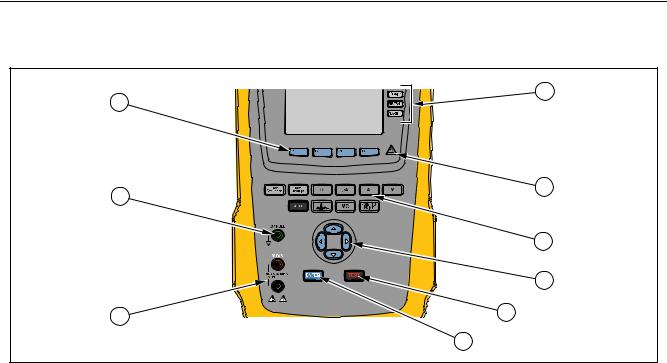
ESA615
Users Manual
Instrument Familiarization
Figure 1 and Table 2 show the front-panel controls and connections of the Product.
9 |
8 |
7 |
6 |
1 |
2 |
3 |
4 |
5 |
gtv116.eps
Figure 1. Front-Panel Controls and Connections
6

Electrical Safety Analyzer
Instrument Familiarization
Item Name
1Equipment Outlet Configuration Buttons
2High Voltage Indicator
3Test Function Buttons
4Navigation Buttons
5Test Button
6Enter Button
7Input Jacks
8Nulling Jack
9Function Softkeys
Table 2. Top-Panel Controls and Connections
Description
Controls the configuration of the equipment outlet. Opens and closes the neutral and ground connection and reverses the polarity of the neutral and hot connection.
Illuminates when high voltage is applied to the ECG/Applied Parts posts or L1 and L2 of the Test Receptacle.
Selects the Product test functions.
Cursor control buttons for navigating menus and lists.
Starts selected tests.
Sets the highlighted function.
Test lead connectors.
Connection to zero test lead resistance.
Keys F1 through F4 are used to select from a number of selections that show in the LCD display above each function softkey.
7
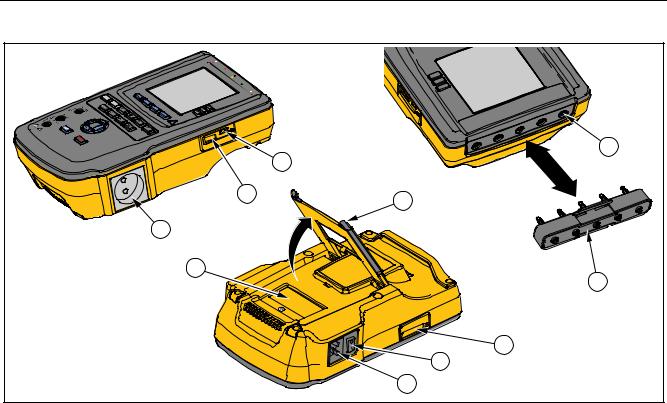
ESA615
Users Manual
Figure 2 and Table 3 describe the side and top-panel connections of the Product.
R RA |
|
F LL |
|
L LA |
|
N RL |
|
C1 |
V1 |
|
9 |
|
3 |
2 |
5 |
|
|
1 |
|
4 |
10 |
|
|
|
6 |
|
7 |
|
8 |
|
gtv110.eps |
Figure 2. Side and Top-Panel Connections
8

Electrical Safety Analyzer
Instrument Familiarization
Table 3. Side and Top-Panel Connections
Item |
Name |
1Equipment Outlet
2USB A Controller Port
3
USB Device Port
(Mini B-style connector)
4Fuse Access Door
5Tilt Stand
6SD Card Slot
7AC Power Switch
8Power Input Connector
9ECG/Applied Parts Jacks
10 Banana Jack to ECG Adapter
Description
Equipment outlet, specified to the version of the Product, which supplies a DUT connection.
For external keyboard or barcode reader.
Digital connection to control the Product from a PC or instrument controller.
Equipment outlet fuse access.
Holds the Product in a tilted position.
SD Memory Card access
Turns ac power on and off.
A grounded male three-prong (IEC 60320 C19) connector that accepts the line-power cord.
Connection posts for Device Under Test (DUT) applied parts, such as ECG leads. Used to test for leakage current through leads and to supply ECG signals and performance waveforms to a DUT.
Adapter to connect ECG snap leads to the Product.
9
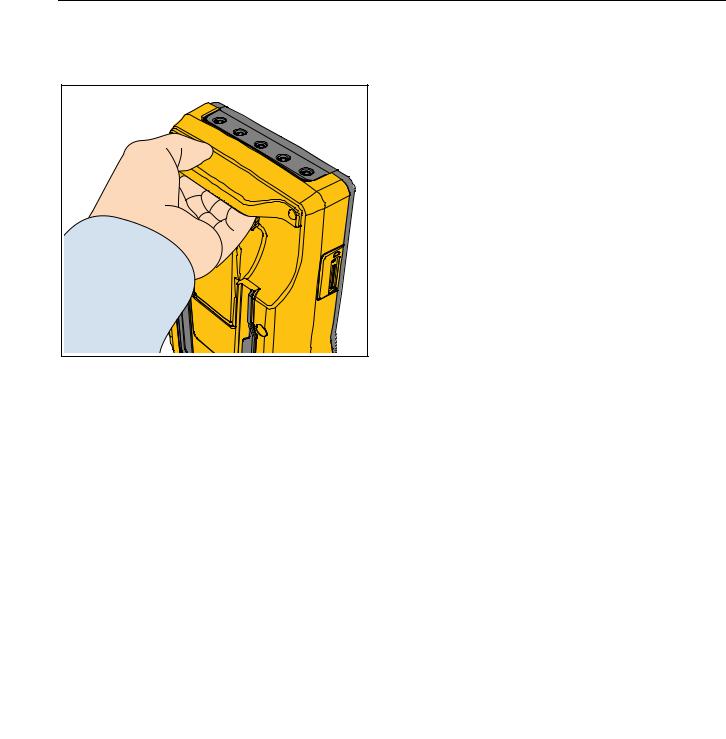
ESA615
Users Manual
How to Hold the Product |
How to Connect to Line Power |
When you move the Product, use the handle on the bottom case to hold it. See Figure .
gtv122.eps |
Warning
To prevent possible electrical shock, fire, or personal injury:
•Do not use an extension cord or adapter plug.
•Make sure the ground conductor in the mains power cord is connected to a protective earth ground. Disruption of the protective earth could put voltage on the chassis that could cause death.
•Replace the mains power cord if the insulation is damaged or if the insulation shows signs of wear.
•Use only the mains power cord and connector approved for the voltage and plug configuration in your country and rated for the Product.
Figure 3. Product Handle
10

Electrical Safety Analyzer
How to Connect a DUT to the Product
The Product is intended for use with single-phase, grounded power. It is not intended for dual, split-phase or three-phase power configurations. It can be used with a power system that supplies the correct voltages for single-phase and is grounded, or is an isolated power system.
Use the power cord for your country mains supply that is not more than the voltage or power rating of the product. Connect the cord into the power input connector and then to the mains outlet.
How to Connect a DUT to the Product
You can connect a Device Under Test (DUT) a number of different ways for a full electrical safety test. Figure shows a DUT connected to the test receptacle, applied parts posts, and a connection to the enclosure or protective earth ground of the DUT.
How to Turn On the Product
Note
To make sure the high voltage indicator works, look for it to illuminate at the power-up.
Push the power switch found on the left-side panel so the “I” side of the ac power switch is down. The Product does a series of self tests and then shows the message in Figure when the self test has completed successfully.
gtv125.bmp
Figure 4. Product Ready for Operation
11
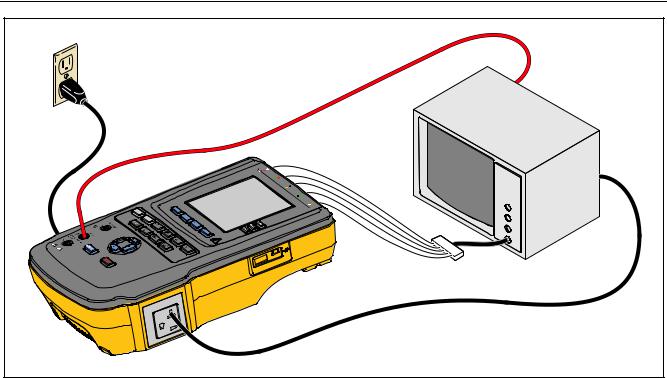
ESA615
Users Manual
To protective earth or any exposed conductive surface on the enclosure
Connect ESA615 to grounded mains socket.
R RA
F LL
L LA
N RL
C1 |
V1 |
Connect the DUT ac power cord to the equipment outlet on the Analyzer
gtv113.eps
Figure 5. DUT Connections to the Product
12

Electrical Safety Analyzer
How to Access the Product Functions
The self-test measures the ac mains input for correct polarity, ground integrity and voltage level. The high voltage indicator illuminates briefly during the self test. If the polarity is reversed, the Product shows this condition and sets the polarity to be reversed internally. If the ground is open, the Product shows this fault. If the mains voltage is too high or too low, the Product shows this fault and does not continue until the supply voltage is corrected and the Product power turned off and then on again.
How to Access the Product Functions
For each test and setup function, the Product uses a series of menus to access different Product tests and setup variables. The example shown in Figure , the Product shows different leakage current tests along the bottom of the display. A More softkey lets you access more menus related to the test. When you push a softkey (F1 through F4) below a test name, the Product sets up for or does the selected test.
For some tests, it will be necessary to set parameters with the navigation buttons. In the example above, the leakage parameter has next to it. This icon shows you must push or to set its value. In this example, the leakage current measurement changes between AC+DC, AC only, or DC only. The applied parts indicator has on the left end and on the right end. These icons show that you must push and to set an applied part.
13

ESA615
Users Manual
How to Connect a PC to the Product
To connect the Product to a PC:
Connect a USB port on your PC or laptop to the Mini B USB device port on the Product.
Or
Plug in an XStick wireless USB dongle to your PC USB port. Products available over wireless will be listed by serial number. Connect to a single Product. See Figure 7.
gtv102.bmp
Figure 6. Leakage Current Menu
The three buttons along the right side of the display ( ) control the wiring of the Product’s test receptacle for some electrical tests. The current condition of these three buttons is shown along the right edge of the display when these controls are active.
Figure 5 shows polarity is settable between normal, reversed, and off. Neutral is also settable to closed or open. Earth condition is not shown, which means it can not be changed. Earth is internally opened while the Product does this test.
14
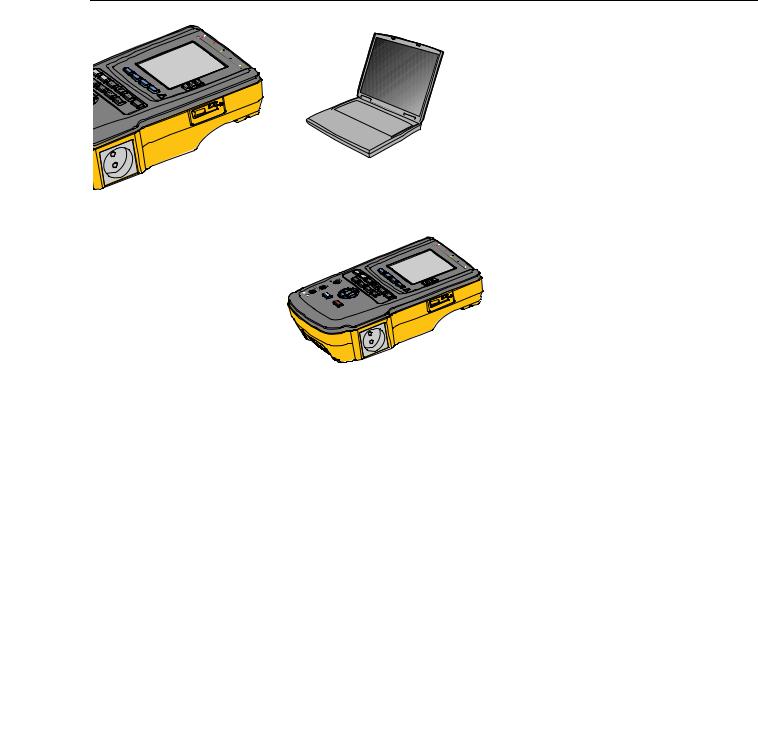
Electrical Safety Analyzer
How to Connect a PC to the Product
V1 |
|
R RA |
|
F LL |
|
L LA |
|
N RL |
|
C1 |
V1 |
|
gtv129.bmp |
Figure 7. Product to PC Connection
15
